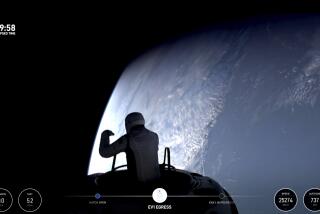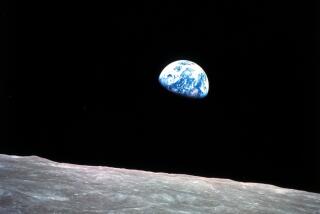The Sky’s No Limit : Armstrong, 4 Other Pilots Inducted Into Walk of Honor
- Share via
Neil Armstrong is best known as the first man to walk on the moon, but on Sunday he confessed that many of the high points of his long career in aerospace took place in the Antelope Valley, where he was a test pilot in the 1950s.
Armstrong, 61, was in Lancaster to be honored along with four other test pilots who flew out of Edwards Air Force Base in the 1950s and ‘60s. All five were inducted into the city’s Aerospace Walk of Honor.
“It’s been fashionable to make fun of the ‘50s as a time of inane beach parties,” Armstrong told the cheering crowd of about 250 people. “I think the 1950s were the most exciting time of my life--right here in the Antelope Valley.”
Armstrong and two of the other inductees--retired Air Force Brig. Gen. Frank Kendall Everest Jr. and retired Air Force Lt. Col. Fitzhugh L. Fulton Jr.--attended the 2 p.m. ceremony in front of Lancaster’s Performing Arts Center. All spoke of the excitement of being involved in testing airplanes and working in the earliest days of the space program.
Two other inductees were deceased pilots--Joseph Walker, who died in a midair collision near Edwards Air Force Base in 1966, and Air Force Maj. Gen. Albert Boyd.
Many who came to witness the induction Sunday were former Edwards base employees and acquaintances of the pilots, who greeted them by their first names after the ceremony.
But to young people, born since Armstrong’s “giant leap for mankind” in 1969, Sunday was an opportunity to meet a near-mythic character from their history books.
As she waited in line to get Armstrong’s autograph, Amy Silva of Palmdale said, “I can’t believe he really went to the moon.” At 13, Silva was born nine years after Armstrong’s moon landing.
Sunday’s five honorees will join Chuck Yeager and four other test pilots who made up the first group inducted into the space walk when it opened last year. The Walk of Honor celebrates Lancaster’s ties to the test pilots who pioneered aerospace development at Edwards Air Force Base, located about 20 miles northeast of the walk.
Each inductee has a six-foot-high, 675-pound granite monument placed along Lancaster Boulevard at Fern Avenue. Each monument includes an 18-inch-wide aluminum logo and a bronze plaque naming the honoree and listing his achievements.
The honorees were selected by a seven-member panel. Five members had military or commercial aviation backgrounds and two of them had non-aerospace backgrounds. Their identities are kept a secret to maintain impartiality, said Lancaster city spokeswoman Nancy Walker.
Sunday’s ceremonies opened in military style with an overhead flight of an F-16 fighter jet and a band playing the national anthem. National Aeronautics and Space Administration chief Richard Truly delivered the keynote address and each of the new inductees gave a short speech.
In their speeches all three spoke fondly of the Antelope Valley back in the 1950s and early 1960s, depicted in Tom Wolfe’s 1979 book “The Right Stuff” and later in the 1983 movie of the same name directed by Philip Kaufman.
“When I first moved to Lancaster, there was only one stoplight--it’s still working,” said Armstrong, who is now an executive with a computer company in his native Ohio.
As a test pilot at Edwards, Armstrong logged more than 6,000 hours of flight time in 200 types of aircraft before moving to the space program in the early 1960s. But in an interview after the induction, he said his favorite thing about the Antelope Valley was the wildflowers that bloom in the spring. “There’s nothing like it.”
Other inductees also stressed their ties to the Antelope Valley.
“It’s great to be honored in your hometown. The Antelope Valley is our home,” said Fulton, a Georgia native who has lived in the Antelope Valley for the past 40 years and raised a family there. “We feel close to this community.”
Fulton had flown more than 16,000 flight hours in about 235 different types of aircraft, testing bombers and transports developed in the past 40 years. He also was a combat pilot in the Korean War and former chief test pilot for NASA.
In his address, Everest, 71, joked with his former colleagues, describing how he and Fulton once dropped a 22,000-pound bomb in the desert during a test.
“We should have used that on Saddam Hussein,” Everest said. “That would have got him in his bunker.”
Everest, an Arizona resident, tested about 122 types of planes at Edwards, logging more than 10,000 flight hours. He said that when he first met Armstrong he could tell the young pilot would reach great heights.
“We always knew that kid with the crew cut would go further than any of us--and he did.”
WALK OF HONOR INDUCTEES
Neil Alden Armstrong
Armstrong, 61, was the first man to walk on the moon, on July 20, 1969, during the three-man Apollo 11 lunar mission. Previously, as a test pilot, he logged more than 6,000 hours of flight time in more than 200 types of aircraft. The Ohio native is now a computer firm executive. Armstrong participated in more than 100 rocket aircraft flights. He was a project pilot for NASA, flying the X-15 rocket aircraft seven times, and was an astronaut on the Gemini 8 mission in March, 1966. Armstrong later was a deputy associate administrator with NASA.
Brig. Gen. Frank Kendall Everest Jr., retired U.S. Air Force
Everest, 71, was a pioneer in U.S. rocket aircraft flying, testing about 122 types of planes and logging more than 10,000 flight hours. He set the Bell X-1 altitude record at 73,000 feet and the world speed record for an F-100A of 755.15 m.p.h. in 1953. Everest played an active role in testing and developing Air Force aircraft at Edwards Air Force Base. He was chief of the flight test operations division there from 1950 to 1956. He also was director of aerospace safety for the Air Force, and test piloted helicopters for Sikorsky Aircraft. He lives in Arizona.
Lt. Col. Fitzhugh L. Fulton Jr., retired U.S. Air Force
Fulton, who still lives in the Lancaster area, had more than 16,000 flight hours in about 235 types of aircraft, having tested most of the U.S. military bombers and transports developed in the past 40 years. He also was a combat pilot in the Korean War and former chief test pilot for NASA. Fulton made 225 trips to Berlin in C-54s during the airlift there. He was chief of the bomber transport test operations division at Edwards when he retired from the Air Force in 1967. In his subsequent work with NASA, he flew the Boeing 747 that ferries the space shuttle.
Maj. Gen. Albert Boyd, U.S. Air Force, deceased
Boyd had more than 23,000 hours of flight time in 723 military aircraft. He died in September, 1976, from natural causes at age 69. When he retired in 1957, he was believed to have flown every plane in the Air Force’s inventory and is considered the “Father of Modern Flight Testing.” Boyd developed and practiced a new philosophy of flight testing that aided in the development of supersonic aircraft. From 1947 to 1957, the Air Force did not buy a single type of airplane that he had not flown and approved. Boyd also was the first commander of the Flight Test Center at Edwards.
Joseph Walker, deceased
Walker was a pioneering test pilot in the X-15 rocket aircraft, setting numerous records and winning many awards during a 21-year career. Walker, who has a junior high school in Quartz Hill named after him, died at age 45 in a June 8, 1966, midair collision near Edwards while he was flying an experimental bomber. Walker flew 58 combat missions during World War II, and received the Distinguished Flying Cross and Air Medal. He was a physicist and chief test pilot for NASA’s Flight Research Center. He also served as project pilot for the Lunar Landing Research Vehicle.
More to Read
Sign up for Essential California
The most important California stories and recommendations in your inbox every morning.
You may occasionally receive promotional content from the Los Angeles Times.













